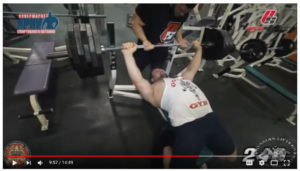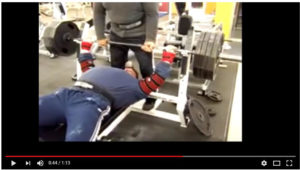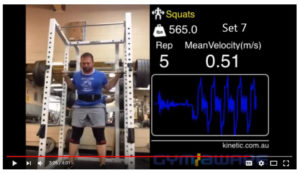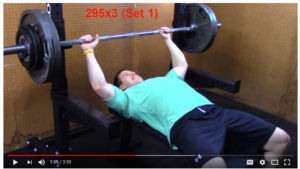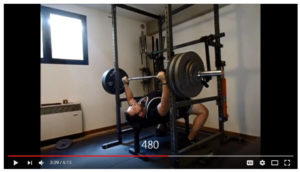Precision Point Training is based on the concept of diagnosing the limit of your capacities for three types of strong training which include:
- Strong Reps
- Strong Sets
- A Strong Lifting Motion
The limit of your capacities for each type of strong training form the precision points that enable you to determine how much, how hard, and heavy you should train. If you exceed your limits for strong training, you will transition into weak training. There are three types of weak training that correspond to each type of strong training. The three types of weak training include:
- Weak Reps
- Weak Sets
- A Weak Lifting Motion
The differences between strong training and weak training are explained in writing along with visual examples in videos.
1. Strong reps vs. Weak Reps
Strong Reps
Strong reps are forceful reps that can be repeated as long as a steady even rep pace can be maintained during a set. When watching the following video of two different lifters, look for the fact that each rep of a set looks the same in terms of force, form, rep speed, and rep pace.
What Strong Reps Look Like
The Limit Rep
The lifters in the above videos push only to their capacity for strong reps. The last strong rep that a lifter can perform before slower weaker reps occur is called a limit rep because it is the limit of strong reps that can be performed. These lifters are stopping at their limit rep which is what I recommend when using precision point training. Your other option is to push one rep past your limit rep which is called your marker rep.
Weak Reps
If you exceed your capacity for strong reps, you start to do weaker slower reps towards the end of a set.
What Weak Reps Look Like
The next video shows a lifter who pushes past his capacity for strong reps as he reaches a point where he can no longer maintain a steady even rep pace. The first five reps are strong reps and the last four reps are weak reps that are performed at a slower pace. Notice that weak reps have nothing to do with being a weak lifter as this lifter is enormously strong, but his last four reps are weaker and slower than his first five.
5 Strong reps followed by 4 weak reps
The lifter in the video that was just shown has a very high capacity to grind out a lot of weaker slower reps when he can no longer keep repeating strong reps. I believe he is testing his strength rather than doing a normal workout where he is training for strength. When testing your strength with max reps, it is almost impossible to avoid weaker slower reps at the end of a set. However, when training for strength, I recommend sticking with precision point training methods in which you either push to the last strong rep, or you may push one rep past your last strong rep. This would be your first weak rep and is called your marker rep.
2. Strong sets vs. Weak Sets
Strong Sets
Strong sets refer to sets that are being done when the muscle group that you are working is at full strength. When using the same weight from one set to the next, each set looks similar or the same in terms of the number of strong reps performed, the speed and pace of the reps, and the amount of time it takes to perform a set. When using different amounts of weight or different exercises from set to set, you must know from previous experience how many strong reps you can normally do when you are at full strength in order to determine whether or not you are performing strong sets.
What Strong Sets Look Like
The next two videos demonstrate what strong sets look like. You will notice that each set looks very similar from start to finish in terms of form and rep speed, which should be the case when you are at full strength for every set. The first lifter can perform eight strong sets, and the second lifter can perform five strong sets. There is a lot of conversation in the first video, but it is unrelated to the purpose of showing what strong sets look like. The main point of the video is to demonstrate what strong sets look like.
8 strong sets. A very high Capacity for sets at full strength
Individual Differences in Capacity
Both lifters in the previous two videos have a very high capacity for strong sets. A more normal capacity is the ability to perform two to four strong sets before strength begins to diminish. The main point is that the number of sets that people can do at full strength can vary substantially from person to person. This being the case, each person must learn from their own experience in order to determine the number of strong sets they can perform at full strength.
The Limit Set
Both lifters in the previous two videos pushed to their capacity of strong sets. The last strong set that a lifter can perform before weak sets occur is called a limit set because it is the limit of strong sets that can be performed. When using precision point training, I recommend stopping at your limit set, or the next set which is called the marker set.
Weak Sets
If you repeat sets to the point where a muscle group is no longer at full strength, you will transition over to weak sets. When doing weak sets, you won’t be able to do the number of strong reps that you can normally do when you are at full strength. The lifter in the next video does two weak sets, which is good for demonstrating what weak sets look like, but when doing precision point training, the recommended options are either to avoid doing any weak sets, or to stop after you reach your first weak set.
What Weak Sets Look Like
The lifter in the following video does three reps per set for five total sets. The first three sets are strong sets that look pretty much the same in terms of speed and force. The last two sets are weak sets because they are slower, and less forceful than the first three. This is not to say that lifters who perform weak sets are weak, because this lifter is obviously strong and is lifting a lot of weight. Weak sets simply refer to doing sets when you are not at full strength.
Sets 1-3 are Strong sets
Sets 4 and 5 are Weak Sets
Mini Sets and Weak Sets
Powerlifters often stop short of a full set and perform less than half of the number of strong reps that they are capable of doing within a set. I call these mini sets. For example, a lifter may have the capacity to do three sets of ten strong reps with a given weight, but instead of doing three sets of ten reps, they do ten mini sets of three reps with the same weight. If you were to do this, it is obvious that you would not be pushing to your limit rep or marker rep on most of your sets which is perfectly ok within the context of using precision point training principles. However, you will eventually reach a mini set that feels weaker and slower, or the last rep of the set starts to slow down. This would be a marker set and an indicator that you should stop doing sets for that muscle group.
A Strong Lifting Motion vs. A Weak Lifting Motion
A Strong Lifting Motion
A strong lifting motion is a smooth nonstop lifting motion with excellent form when performing heavy single reps. The upward positive portion of the lifting motion should not take much longer than one full second, and certainly no more than two seconds. You will see this in this in the following two videos.
What A Strong Lifting Motion Looks Like
Strong Lifting Motion For A Heavy Single Rep
Ed Coan trains within his capacity to perform a strong lifting motion
The Limit Weight
The lifters that were shown in the last two videos are right at their capacities for a strong lifting motion. They are using their limit weight as it is the limit of weight that these lifters can use before a weak lifting motion occurs.
A Weak Lifting Motion
When performing a weak lifting motion, any of the following characteristics may be observed during the lift:
A slight pause or slowing down of the bar occurs at some point during the lifting motion
The lift may look smooth, but it is very slow and takes more than 2 full seconds.
The lift starts out somewhat slow and speeds up at the end or vice versa.
It may also be a weight that is sufficient to cause an obvious decrease in rep speed compared to a lift that was only ten pounds lighter.
What a Weak Lifting Motion Looks Like
The lifter in the above video is testing his strength rather than training for strength. When testing for strength with the heaviest weight possible, it is almost impossible to avoid a weak lifting motion, even if you are strong, which this lifter is. However, if you train with heavy singles on a regular basis, the vast majority of your single reps should be performed with a strong lifting motion.
Limit Training Vs. Marker Training
The main objective of precision point training is to expand your capacity for strong training. If you succeed, you will gain strength. There are two basic approaches to expanding your capacity for strong training. These two approaches consist of:
- Limit Training
- Marker Training
These two approaches are summarized below:
The Limit Training Approach
When you challenge your capacity strong training to expand by training to your limit of strong reps, strong sets, and a strong lifting motion, you are utilizing the limit training approach.
The limit training approach is based on three types of limit training including:
- The limit Rep: The limit of strong reps that you can repeat when performing a set.
- The limit Set: The limit of strong sets you can repeat at full strength.
- The limit Weight: the limit of weight you can use while maintaining a strong lifting motion.
Examples of limit training have already been shown in the previous videos that demonstrated strong reps, strong sets, and a strong lifting motion.
The Marker Training Approach
When you challenge your capacity for strong training to expand by slightly exceeding your limit for strong reps, strong sets, and a strong lifting motion, you are utilizing the marker training approach.
The marker training approach is based on three types of marker training including:
- The Marker Rep: The first weak rep that occurs immediately after your limit rep.
- The Marker Set: The first weak set that occurs immediately after you limit set.
- The Marker Weight: The first sign of a weak lifting motion after increasing the weight past your limit weight.
Marker Training
In order to engage in marker training, you must be able to identify the marker rep, the marker set, and marker weights. It helps to have visual examples of each type of marker training in order to identify when it is occurring in your training. These examples are shown in the next series of videos.
What the Marker Rep Looks Like (10th rep)
In the above video, the lifter slows down a slight amount on his 9th rep and some people may choose to call it a marker rep. But the most sudden obvious slowing down happens when he pauses between his ninth tenth rep. This pause often occurs right before a lifter reaches his or her marker rep, but not always.
What the Marker Set Looks Like (The 7th Set)
The lifter in the above video does 8 sets, but he actually hits his marker set on his 7th set. The first six sets look pretty much the same in terms of rep speed and they are all strong sets, but he slows down a little at the end of his 7th set. Since his 7th set is a little slower and weaker than the previous sets, it is marker set and is where you would stop if using precision point training methods.
What the Marker Set Looks Like (4th Set)
The video above was already shown in the section on weak reps, but it also shows an example of a marker set, which occurs on his fourth set. The lifter in the above video is very aware of his power and rep speed from set to set. His first three sets look almost the same and they are all strong sets consisting of strong reps. He does five total sets, but his marker set is actually his fourth set. It is a weaker slower set in comparison to the first three sets and it is where you would stop if you were using precision point training methods.
What the Marker Weight Look Like
The lifter in the video starts to slow down slightly in the middle of the lifting motion and there is a slight break in his form as his right arm is a little slower than his left. He is lifting 187 pounds which is a personal record. Although it is not shown in the video, he tries for 200 pounds on his next attempt but can’t quite get it up. 187 pounds is the point at which a slight disruption in a strong lifting motion begins to appear, which makes it his marker weight. The marker weight is the heaviest weight that you would want train with when using precision point training methods. You wouldn’t add weight until the lifting motion completely smooths out into a smooth nonstop lifting motion.
The transition points between strong training and weak training are thresholds that identify precision points. Precision points are used to identify how hard, how long, and how heavy to train in order to achieve an optimum training state for optimum results. The exact reasoning behind why precision points are effective is explained in The Basics of PPT at http://www.precisionpointtraining.com/the-basics-of-ppt-strength-training/.
Differences in how Progress With Limit Training versus Marker Training
Progressing With Limit Training
When using the limit rep, limit set, and limit weight, you can progress by adding weight. Keep pushing to your limit rep, limit set, and limit weight, until you gain enough strength to add 5 to 10 pounds without surpassing your limit rep, limit set, or limit weight. You can also combine limit training with microloading by adding a half pound to a pound to your lifts every week. The goal of this is to gain strength as weight is added so that the additions of weight never become more difficult to lift. When done correctly, you will never surpass your limit rep, limit set, or limit weight, even though the additions of weight will add up to much heavier weights over the course of long term lifting.
Progressing With Marker Training
When using marker training, you progress by using the same amount of reps, same amount of sets, and same amount of weight from workout to workout until the same training becomes easier. As you continue to do this, you will eventually gain enough strength to transition to limit training with the same sets, reps, and weight. In other words, the slower weaker marker rep will start to speed up as it becomes easier and transitions into a faster limit rep. Marker sets will become easy enough to transition into limit sets, and a weak lifting motion will vanish as a marker weight transitions into a limit weight. Once marker training has become easy enough to transition into limit training, then you can add five to ten pounds of weight and repeat the process.
For more information about precision point training, refer to the books, blogs, and information on http://www.precisionpointtraining.com/. Best of training to you.

